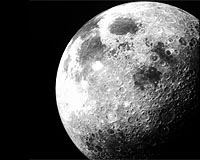 |
Huntsville AL (SPX)) Nov 19, 2009 NASA has successfully completed a series of autonomous "drop" tests of a robotic lander test article - in a record 10 months - to demonstrate the ability to perform a controlled landing on the moon or other airless planetary bodies. During recent tests at NASA's Marshall Space Flight Center in Huntsville, Ala., the lander test article was suspended up 10.5 feet from the landing pad. Released from its hoist, the lander simultaneously received a command to activate its onboard thrusters to carry it to a controlled landing using a preprogrammed descent profile. These tests demonstrate the test article's capability to perform autonomous descent, and soon will be used to checkout landing control algorithms for the next generation of lander missions. "Demonstrating autonomous flight and descent in this short amount of time is a major accomplishment," said Julie Bassler, Robotic Lunar Lander Development Project Manager at the Marshall Center. "The proven capability of this test platform reduces our technical risks and brings us one step closer to building a flight robotic lander capable of carrying both scientific and exploration payloads to the lunar surface." The test article uses compressed air for safe operations and quick turn-around times, allowing engineers to perform multiple tests in a day and make adjustments as necessary. The test article is compact - standing at 3 feet tall and weighing 270 pounds. The article is roughly the same size as the actual flight lander, designed to operate through long lunar nights, and capable of landing on the near or far side of the moon and inside or on the edge of craters. The project team is also working on a "warm gas" test article, using a more energetic propellant than compressed air. The warm gas test article will add to the functionality of the cold gas article by demonstrating performance of flight avionics and sensor components as well as software based on the spaceflight vehicle. The warm gas test article will provide longer flight time - approximately one minute - and will operate at greater altitudes. It is expected to be operational next summer. "The moon is a fascinating, complex world." said planetary scientist Barbara Cohen of Marshall's Science and Mission Systems Office. "This new generation of small robotic landers will be capable of carrying scientific instruments to the lunar surface that could perform a variety of investigations, including those that enhance our understanding of the moon's deep interior, surface geological processes, and the existence of lunar ice and water at the poles." Another significant milestone for the Robotic Lunar Lander Development Project was the successful hot-fire thruster testing of a candidate descent thruster at NASA's White Sands Test Facility in Las Cruces, N.M., using technology developed for the nation's ballistic missile defense system. The thruster was put through a 16-minute, full-duration firing sequence to simulate a lunar landing, including continuous burns up to 10 times longer than typically required for missile defense systems. Test data is currently being analyzed to better understand the complexities of performing a safe moon landing. "This important thruster test demonstrates the potential to leverage an existing government investment for a new and exciting application, reducing our technical risk and saving taxpayer dollars at the same time," said Marshall engineer Danny Harris of the Engineering Directorate. The Robotic Lunar Lander Development Project is a team of industry, government and not-for-profit collaborators, including the Marshall Center, Johns Hopkins University Applied Physics Laboratory in Laurel, Md., and the Von Braun Center for Science and Innovation in Huntsville. This team is designing and building the "next generation" of robotic landers that can carry a broad range of science payloads and devices, including geophysical measurement instruments, volatile measurement instruments or possibly lunar sample returns. Share This Article With Planet Earth
Related Links Robotic Lunar Lander Development Project Mars News and Information at MarsDaily.com Lunar Dreams and more
 Moon holds key to solar system's secrets
Moon holds key to solar system's secretsWashington (AFP) Nov 13, 2009 The moon, which is once again the focus of an international space race, could hold the key to the birth of our planet some 4.5 billion years ago, and help unlock the oldest secrets of the universe. Forty years after American Neil Armstrong first walked on the moon, and as the United States aims to return astronauts to Earth's nearest neighbor by 2020, it remains an object of fascination and ... read more |
|
| The content herein, unless otherwise known to be public domain, are Copyright 1995-2009 - SpaceDaily. AFP and UPI Wire Stories are copyright Agence France-Presse and United Press International. ESA Portal Reports are copyright European Space Agency. All NASA sourced material is public domain. Additional copyrights may apply in whole or part to other bona fide parties. Advertising does not imply endorsement,agreement or approval of any opinions, statements or information provided by SpaceDaily on any Web page published or hosted by SpaceDaily. Privacy Statement |